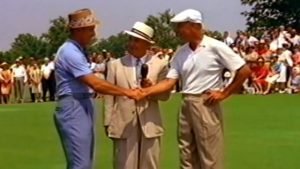The Face-Off between Hogan and Snead.
Golf Blog by the Mel Sole Golf School.
It was, in a sense, the Match of the Century.
Two of the greatest players in golf's long history faced off in an 18-hole stroke-play competition. Appropriately, 3.7 million viewers saw the event. One of the largest TV audiences recorded at the time for a golf event.
Who wouldn't want to watch Ben Hogan go mano a mano with Sam Snead?
In 1961, the first Shell's Wonderful World of Golf challenge match aired. The series, which ran for nine years and was brought back for another decade, from 1994 to 2003. It pitted notable players of the day against one another on courses around the globe. Not all of the showdowns had the firepower and appeal of Hogan/Snead. The series' second and third installments featured dust-ups between Ted Kroll and Chen Ching-Po and Jay Hebert and Flory Van Donck. But some—like the Gene Littler/ Byron Nelson battle at Pine Valley, in 1962—were indelible television.
The Hogan/Snead match was effectively an exhibition.
There wasn't much money or glory: $3,000 to the winner, $2,000 to the loser. No green jackets or glittering trophies. Only a few column inches in the sports pages. That took nothing away from its significance, symbolic or otherwise. Given their larger-than-life personas and competitive records, Hogan and Snead could have played for marbles on a muni in Muncie, Ind., and they'd have commanded the attention of even the most indifferent golf fans.
It was a given that these two proud and fierce competitors would play the match as though it were a major championship, and they did. Contested at the Houston Country Club in May 1964 and airing the following year, it marked the last time these Goliaths of the game would meet in competition. And unbeknownst to them and to everyone else at the time, the clash would have momentous consequences for the future of the game.
A bit of transparency.
I was a young writer on Shell's Wonderful World of Golf, having been hired only two weeks earlier for my first job in what would become my lifetime profession. It was a baptism by fire.
The show was the brainchild of Monroe Spaght, then president of Shell USA and an ardent golfer. Spaght was spinning off the first such made-for-television, one-on-one links series, All-Star Golf, which was produced by Chicago's renowned public-course operator Joe Jemsek and his partner, Pete DeMet. From 1957 through 1963, they aired a series of 18-hole matches between the game's best pros (including Snead, Gene Littler, Cary Middlecoff, Julius Boros and Tommy Bolt), with most of the battles played on Jemsek-owned tracks.
The production values of the black-and-white show were primitive.
Hole diagrams looked as though they'd been pulled from a pre-teen's coloring book, and only a scant few camera shots of flighted balls were captured. Jemsek himself said of those pioneering but crude shows, "We were making home movies." Despite that, All-Star Golf had attracted a substantial viewership. Spaght noted the success and decided to take it a step—in fact, a few giant steps—further.
The Shell show matches would be played in every corner of the world, on famous courses, whenever possible, and filmed in vibrant color. The distinguished golf writer Herbert Warren Wind was brought in to consult. He came up with the basic format, suggested which courses to play, and was instrumental in recruiting the storied player of the 1920s and ?30s, Gene Sarazen, as host.
The Squire appeared on camera in tailored knickers, a smart sport coat, shirt and tie, and a panama hat. Spaght burnished Jemsek's concept, and it worked. Landing the elusive Hogan only heightened the show's luster.
Ben Hogan.
Bantam Ben, who won his nine major championships between 1946 and 1953, had become increasingly reclusive in the 60s. At most he was playing four tournaments a year, and he showed little interest in the perks that come with legend status. Designing courses, commenting for TV, or promoting a tournament in his name. I once asked Hogan if, as a Tour player, he ever considered himself an entertainer. His response was a curt, unequivocal "No." So it came as a surprise that he would deign to participate in a glitzy exhibition. Shell had a coup, and, as was often the case with the stone-faced but mesmerizing Texan, Hogan became the story.
He wasn't doing anyone a favor, mind you. Quite the opposite. To prop up a struggling line of golf equipment he had launched in 1955, Hogan had a pressing need for publicity. He also needed cash, and he got it. A $25,000 appearance fee he put in his pocket on the side was a Shell secret for years. Maybe he had a payroll to make. In any case, Spaght was willing to break precedent. Everyone else played only for prize money, plus expenses.
Sam Snead.
Sam Snead wasn't as exclusive or expensive as Hogan. Around the time of the made-for-TV match, the ageless Slammin' Sam was still playing the Tour—and still playing it at a high level—and he would win his 82nd and final Tour title at the 1965 Greater Greensboro Open, just two months shy of his 53rd birthday. Snead just loved to play, especially against the Hawk, "because he never says anything to you, except now and then, "You're away,"" Snead once explained. Indeed, Hogan stayed true to form. During the Houston match, they conversed little. Play got under way at 9 a.m. on a gray day with a forecast of heavy rain.
A downpour started in the middle of the second hole, which the warriors played out. On the third, with the arrival of thunder and lightning with a particular Texas violence, they had to evacuate the course. A few of us, including Hogan and Snead, took refuge in a room just off the pro shop. Hogan sat quietly with a towel wrapped around his shoulders. Snead, on the other hand, was rarely quiet—the Virginia mountain boy was a colorful storyteller. Hogan managed only a strained smile, then exited the room.
Read the rest of this article on the match between Ben Hogan and Sam Snead, go here!
The 31 Greatest Ben Hogan Photos Of All Time
Source: Al Barkow GOLF Mel Sole Golf School
Pictures: GOLF
Thanks for reading - The Face-Off between Hogan and Snead. What a historic match!
Related Posts.
Matching Lines – Short Game Saturday #52.
Top 10 Jack Nicklaus Moments. #3 is Great!
Memorable Golf Quotes from the Greats!
PLEASE SUBSCRIBE TO MY CHANNEL, LIKE THIS VIDEO, SHARE IT WITH A FRIEND, LEAVE A COMMENT!

